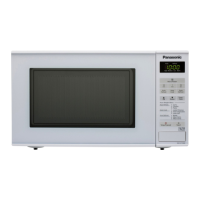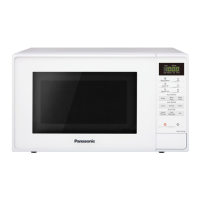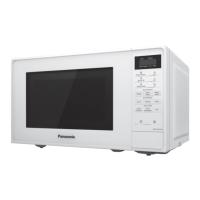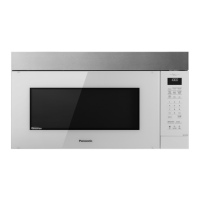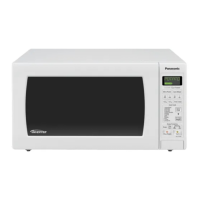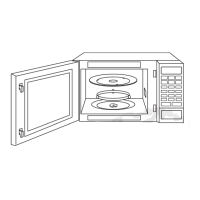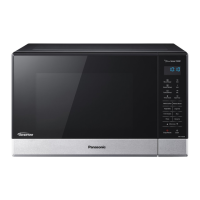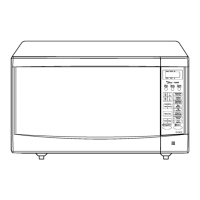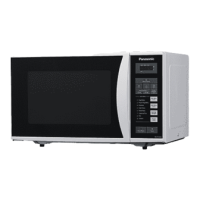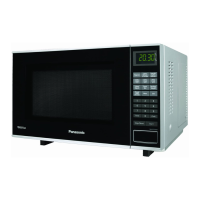Do you have a question about the Panasonic NN-ST251W and is the answer not in the manual?
Emphasizes the importance of proper earthing for personal safety.
Guidelines for positioning the oven for optimal operation and safety.
Guidance on short cooking times, undercooking vs overcooking, and handling small food portions.
Warnings for Christmas puddings, boiled eggs, foods with skins, liquids, lids, and deep fat frying.
Explains the process of microwave heating through water molecule vibration.
Lists foods like Yorkshire puddings and soufflés that require dry heat.
Explains the role of standing time for heat conduction and even cooking.
Identifies key parts like the turntable, roller ring, and control panel via a diagram.
Guidelines for using and cleaning the glass turntable and its weight limit.
Details the functions of buttons and dials for the NN-SM221W model.
Explains the functions of buttons and pads for the NN-ST271S model.
Explains the need for standing time for dense foods to finish cooking.
How cling film helps retain moisture and speed up cooking; includes piercing instructions.
Stir liquids before, during, and after heating to prevent eruptions.
Keep the oven clean to maintain safe operation; use mild detergent.
A method to check if cookware is microwave-safe using water.
Prohibits foil and metal containers as they can damage the oven.
Use microwave-safe plastic; avoid melamine and containers for high sugar/fat foods.
Small amounts can shield food; foil must not touch oven walls to prevent arcing.
Do not use for non-food items, drying materials, or operating without food.
Guidelines for servicing, door seals, and oven light replacement.
Explains how to select power levels (Max, Medium, Low, Defrost, Simmer).
How to select defrost power and set defrosting time.
Step-by-step guide to setting the time of day on the display.
How to activate and deactivate the child lock feature for safety.
How to program two cooking stages that switch power automatically.
Select program, then enter weight using 'More'/'Less' buttons.
Specific advice for defrosting bread, meat items, and whole chickens.
Arrange food, check progress, turn/mix, and shield parts with foil if needed.
Use programs only for described foods within the recommended weight range.
Programs for reheating fresh meals and beverages using automatic settings.
Programs for cooking fresh vegetables, fish, and potatoes with weight input.
Reheat food quickly on HIGH power; cover wet foods, not dry foods.
Reheating times vary by food content; spread dense items out.
Stir soups before, during, and after heating; stir casseroles halfway and at the end.
Explains normal oven behaviors like TV interference and steam.
Lists common problems like 'Oven not turning on' and their solutions.
How to clean interior, exterior, and control panel with damp cloths and mild detergent.
Lists power source, consumption, output, dimensions, and weight.
Unpack and inspect for damage; notify dealer if any is found.
Emphasizes the necessity of earthing for safety and replacing non-earthed sockets.
Guidelines on positioning the oven for proper ventilation and accessibility.
Use only for food preparation; do not use for chemicals or drying materials.
Instructions for repair, door seals, and lamp replacement by qualified personnel.
Fire prevention, immediate actions for smoke, and safe operation without food.
Short cooking times, checking food frequently, and avoiding overcooking.
Caution with items like bread, popcorn; avoid non-food items like wheat bags.
Warnings for Christmas pudding, boiled eggs, foods with skins, liquids, lids, and deep frying.
Explains microwave energy generation and absorption by water molecules.
Use oven mitts; microwaves don't pass through metal.
Lists items like puddings, soufflés, and fried foods not suitable for microwave use.
Do not boil eggs in shells due to explosion risk causing injury.
Importance of standing time for heat conduction when the oven is off.
Identifies parts like ventilation, window, door lock, power cord, and panel via a diagram.
Instructions for cleaning the roller ring and using it with the turntable.
Explains the functions of timer, power selection, defrost, and door release for NN-SM221W.
Details the functions of display, power, time, auto programs, and start/stop buttons for NN-ST271S.
Food requires standing time after cooking for heat to distribute evenly.
Porous foods heat faster than dense foods.
Check food readiness even with auto programs; return to oven if needed.
Keep the oven clean to prevent damage and ensure safety.
Test cookware with water to check if it's microwave-safe.
Prohibits foil and metal containers as they can damage the oven.
Use microwave-safe plastic; avoid melamine and high sugar/fat foods.
Use small amounts to shield food; keep foil away from oven walls.
Useful for roasting meat; do not use metal twists.
How to select power levels and notes on checking food and using the timer.
States the defrost power is 270 W and how to set defrost time.
Step-by-step guide to setting the time of day on the display.
How to activate and deactivate the child lock feature for safety.
Lists power levels from High (800W) to Boiling (250W).
How to program two cooking stages that switch power automatically.
Select program, then enter weight using 'More'/'Less' buttons.
Specific advice for defrosting bread, meat items, and whole chickens.
Arrange food, check progress, turn/mix, and shield parts with foil if needed.
Use programs only for described foods within the recommended weight range.
Programs for reheating fresh meals and beverages using automatic settings.
Programs for cooking fresh vegetables, fish, and potatoes with weight input.
Reheat portioned meals evenly; spread dense items out.
Remove canned food and place in a suitable dish before heating.
Stir soups before, during, and after heating; stir casseroles halfway and at the end.
Reheating bread products will result in a soft base.
Reheat canned beans and pasta in a microwave-safe dish, covered.
Reheat canned soups in a microwave-safe bowl, covered.
Reheat puddings in a microwave-safe dish, covered.
Overheating may cause ignition; do not leave unattended.
Reheat coffee in a mug, stir before, during, and after.
Reheat milk in a mug, stir before, during, and after.
Reheat chilled convenience meals in a suitable dish, not in foil containers.
Reheat frozen convenience meals in a suitable dish, not in foil containers.
Cook bacon on a microwave-safe plate or rack, not covered.
Cook pre-soaked beans and pulses in a shallow dish with water, covered.
Handle veal carefully due to hot fat; cook on a rack or inverted dish.
Handle chicken carefully due to hot fat; cook on an inverted dish.
Poach eggs in water, with specific steps for yolk piercing and cooking times.
Scramble eggs with milk and butter; cook and stir for best results.
Cook frozen fish fillets or whole fish with added liquid, covered.
Cook fruit like apples and plums in a shallow dish, half-filled, covered, and stirred.
Handle lamb carefully due to hot fat; cook on a rack or inverted dish.
Cook pasta in a large container with boiling water, covered.
Reheat chilled pizza on a heatproof plate, not covered.
Handle pork carefully due to hot fat; cook on a rack or inverted dish.
Cook porridge in a large container with water or milk, stirred.
Cook rice in a large container with boiling water, covered.
Cook sausages on a microwave-safe plate or rack, covered.
Cook fresh vegetables in a shallow dish with added water, covered.
Cook frozen vegetables in a shallow dish with added water, covered.
Explains normal oven behaviors like TV interference and steam.
Lists common problems like 'Oven not turning on' and their solutions.
How to clean interior, exterior, and control panel with damp cloths and mild detergent.
Lists power source, consumption, output, dimensions, and weight.
Emphasizes the importance of proper earthing for personal safety.
Guidelines for positioning the oven for optimal operation and safety.
Guidance on short cooking times, undercooking vs overcooking, and handling small food portions.
Warnings for Christmas puddings, boiled eggs, foods with skins, liquids, lids, and deep fat frying.
Explains the process of microwave heating through water molecule vibration.
Lists foods like Yorkshire puddings and soufflés that require dry heat.
Explains the role of standing time for heat conduction and even cooking.
Identifies key parts like the turntable, roller ring, and control panel via a diagram.
Guidelines for using and cleaning the glass turntable and its weight limit.
Details the functions of buttons and dials for the NN-SM221W model.
Explains the functions of buttons and pads for the NN-ST271S model.
Explains the need for standing time for dense foods to finish cooking.
How cling film helps retain moisture and speed up cooking; includes piercing instructions.
Stir liquids before, during, and after heating to prevent eruptions.
Keep the oven clean to maintain safe operation; use mild detergent.
A method to check if cookware is microwave-safe using water.
Prohibits foil and metal containers as they can damage the oven.
Use microwave-safe plastic; avoid melamine and containers for high sugar/fat foods.
Small amounts can shield food; foil must not touch oven walls to prevent arcing.
Do not use for non-food items, drying materials, or operating without food.
Guidelines for servicing, door seals, and oven light replacement.
Explains how to select power levels (Max, Medium, Low, Defrost, Simmer).
How to select defrost power and set defrosting time.
Step-by-step guide to setting the time of day on the display.
How to activate and deactivate the child lock feature for safety.
How to program two cooking stages that switch power automatically.
Select program, then enter weight using 'More'/'Less' buttons.
Specific advice for defrosting bread, meat items, and whole chickens.
Arrange food, check progress, turn/mix, and shield parts with foil if needed.
Use programs only for described foods within the recommended weight range.
Programs for reheating fresh meals and beverages using automatic settings.
Programs for cooking fresh vegetables, fish, and potatoes with weight input.
Reheat food quickly on HIGH power; cover wet foods, not dry foods.
Reheating times vary by food content; spread dense items out.
Stir soups before, during, and after heating; stir casseroles halfway and at the end.
Explains normal oven behaviors like TV interference and steam.
Lists common problems like 'Oven not turning on' and their solutions.
How to clean interior, exterior, and control panel with damp cloths and mild detergent.
Lists power source, consumption, output, dimensions, and weight.
Unpack and inspect for damage; notify dealer if any is found.
Emphasizes the necessity of earthing for safety and replacing non-earthed sockets.
Guidelines on positioning the oven for proper ventilation and accessibility.
Use only for food preparation; do not use for chemicals or drying materials.
Instructions for repair, door seals, and lamp replacement by qualified personnel.
Fire prevention, immediate actions for smoke, and safe operation without food.
Short cooking times, checking food frequently, and avoiding overcooking.
Caution with items like bread, popcorn; avoid non-food items like wheat bags.
Warnings for Christmas pudding, boiled eggs, foods with skins, liquids, lids, and deep frying.
Explains microwave energy generation and absorption by water molecules.
Use oven mitts; microwaves don't pass through metal.
Lists items like puddings, soufflés, and fried foods not suitable for microwave use.
Do not boil eggs in shells due to explosion risk causing injury.
Importance of standing time for heat conduction when the oven is off.
Identifies parts like ventilation, window, door lock, power cord, and panel via a diagram.
Instructions for cleaning the roller ring and using it with the turntable.
Explains the functions of timer, power selection, defrost, and door release for NN-SM221W.
Details the functions of display, power, time, auto programs, and start/stop buttons for NN-ST271S.
Food requires standing time after cooking for heat to distribute evenly.
Porous foods heat faster than dense foods.
Check food readiness even with auto programs; return to oven if needed.
Keep the oven clean to prevent damage and ensure safety.
Test cookware with water to check if it's microwave-safe.
Prohibits foil and metal containers as they can damage the oven.
Use microwave-safe plastic; avoid melamine and high sugar/fat foods.
Use small amounts to shield food; keep foil away from oven walls.
Useful for roasting meat; do not use metal twists.
How to select power levels and notes on checking food and using the timer.
States the defrost power is 270 W and how to set defrost time.
Step-by-step guide to setting the time of day on the display.
How to activate and deactivate the child lock feature for safety.
Lists power levels from High (800W) to Boiling (250W).
How to program two cooking stages that switch power automatically.
Select program, then enter weight using 'More'/'Less' buttons.
Specific advice for defrosting bread, meat items, and whole chickens.
Arrange food, check progress, turn/mix, and shield parts with foil if needed.
Use programs only for described foods within the recommended weight range.
Programs for reheating fresh meals and beverages using automatic settings.
Programs for cooking fresh vegetables, fish, and potatoes with weight input.
Reheat portioned meals evenly; spread dense items out.
Remove canned food and place in a suitable dish before heating.
Stir soups before, during, and after heating; stir casseroles halfway and at the end.
Reheating bread products will result in a soft base.
Reheat canned beans and pasta in a microwave-safe dish, covered.
Reheat canned soups in a microwave-safe bowl, covered.
Reheat puddings in a microwave-safe dish, covered.
Overheating may cause ignition; do not leave unattended.
Reheat coffee in a mug, stir before, during, and after.
Reheat milk in a mug, stir before, during, and after.
Reheat chilled convenience meals in a suitable dish, not in foil containers.
Reheat frozen convenience meals in a suitable dish, not in foil containers.
Cook bacon on a microwave-safe plate or rack, not covered.
Cook pre-soaked beans and pulses in a shallow dish with water, covered.
Handle veal carefully due to hot fat; cook on a rack or inverted dish.
Handle chicken carefully due to hot fat; cook on an inverted dish.
Poach eggs in water, with specific steps for yolk piercing and cooking times.
Scramble eggs with milk and butter; cook and stir for best results.
Cook frozen fish fillets or whole fish with added liquid, covered.
Cook fruit like apples and plums in a shallow dish, half-filled, covered, and stirred.
Handle lamb carefully due to hot fat; cook on a rack or inverted dish.
Cook pasta in a large container with boiling water, covered.
Reheat chilled pizza on a heatproof plate, not covered.
Handle pork carefully due to hot fat; cook on a rack or inverted dish.
Cook porridge in a large container with water or milk, stirred.
Cook rice in a large container with boiling water, covered.
Cook sausages on a microwave-safe plate or rack, covered.
Cook fresh vegetables in a shallow dish with added water, covered.
Cook frozen vegetables in a shallow dish with added water, covered.
Explains normal oven behaviors like TV interference and steam.
Lists common problems like 'Oven not turning on' and their solutions.
How to clean interior, exterior, and control panel with damp cloths and mild detergent.
Lists power source, consumption, output, dimensions, and weight.
| Type | Microwave Oven |
|---|---|
| Power Output | 900 Watts |
| Capacity | 1.2 cubic feet |
| Control Type | Electronic |
| Turntable Diameter | 12.4 inches |
| Dimensions (W x H x D) | 443 x 258 x 340 mm |
| Weight | 30.9 pounds |
| Oven Capacity | 20 L |
| Microwave Power | 800 W |
| Power Levels | 5 |
| Exterior Dimensions (W x H x D) | 443 x 258 x 340 mm |
| Exterior Dimensions | 443 x 258 x 340 mm |
| Color | White |
| Cooking Modes | Defrost |
